
Hard bop is a subgenre of jazz that is an extension of bebop music. Journalists and record companies began using the term in the mid-1950s to describe a new current within jazz that incorporated influences from rhythm and blues, gospel music, and blues, especially in saxophone and piano playing.
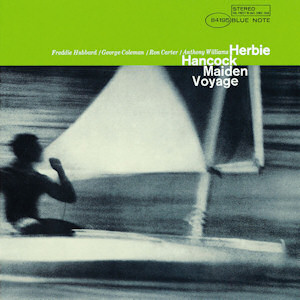
Maiden Voyage is the fifth album led by jazz musician Herbie Hancock, and was recorded by Rudy Van Gelder on March 17, 1965, for Blue Note Records. It was issued as BLP 4195 and BST 84195. Featuring Hancock with tenor saxophonist George Coleman, trumpeter Freddie Hubbard, bassist Ron Carter and drummer Tony Williams, it is a concept album aimed at creating an oceanic atmosphere. As such, many of the track titles refer to marine biology or the sea, and the musicians develop the concept through their use of space. The album was presented with the Grammy Hall of Fame Award in 1999.

Filles de Kilimanjaro is a studio album by the American jazz trumpeter Miles Davis. It was recorded in June and September 1968 at Columbia 30th Street Studio in Manhattan, and released on Columbia Records in December of that year in the United Kingdom and in the United States the following February. The album is a transitional work for Davis, who was shifting stylistically from acoustic post-bop recordings with his Second Great Quintet to the jazz fusion of his subsequent "electric period". Filles de Kilimanjaro was well received by contemporary music critics, who viewed it as a significant release in modern jazz. Pianist Chick Corea and bassist Dave Holland appear on two tracks, tmarking heir first participation on a Davis album.

Milestones is a studio album by Miles Davis. It was recorded with his "first great quintet" augmented as a sextet and released in 1958 by Columbia Records.
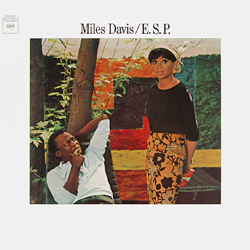
E.S.P. is an album by Miles Davis, recorded on January 20–22, 1965 and released on August 16 of that year by Columbia Records. It is the first release from what is known as Davis's second great quintet: Davis on trumpet, Wayne Shorter on tenor saxophone, Herbie Hancock on piano, Ron Carter on bass, and Tony Williams on drums. The album was named after a tune by Shorter, and was inspired by the fact that, "since Wayne Shorter's arrival, the five members of the quintet seemed to communicate by mental telepathy."

Miles Smiles is an album by the jazz musician Miles Davis. It was released on February 16, 1967 through Columbia Records. It was recorded by Davis and his second quintet at Columbia 30th Street Studio in New York City on October 24 and October 25, 1966. It is the second of six albums recorded by Davis' second great quintet, which featured tenor saxophonist Wayne Shorter, pianist Herbie Hancock, bassist Ron Carter, and drummer Tony Williams.

Nefertiti is a studio album by the jazz trumpeter and composer Miles Davis. It was released in March 1968 through Columbia Records. The recording was made at Columbia's 30th Street Studio over four dates between June 7 and July 19, 1967, the album was Davis' last fully acoustic album. Davis himself did not contribute any compositions – three were written by tenor saxophonist Wayne Shorter, two by pianist Herbie Hancock, and one by drummer Tony Williams.
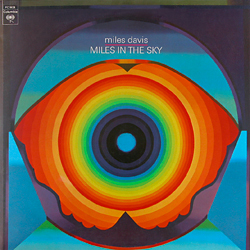
Miles in the Sky is a studio album by the jazz trumpeter and composer Miles Davis. It was released on July 22, 1968 through Columbia Records. It was the last full album recorded by Davis' "Second Great Quintet" and marked the beginning of his foray into jazz fusion, with Herbie Hancock playing electric piano and Ron Carter playing electric bass guitar on opening track “Stuff”. Additionally, electric guitarist George Benson features on “Paraphernalia”.
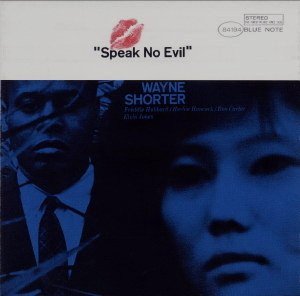
Speak No Evil is the sixth album by Wayne Shorter. It was released in June 1966 by Blue Note Records. The music combines elements of hard bop and modal jazz, and features Shorter on tenor saxophone, trumpeter Freddie Hubbard, pianist Herbie Hancock, bassist Ron Carter and drummer Elvin Jones. The cover photo is of Shorter's first wife, Teruko (Irene) Nakagami, whom he met in 1961.

Walkin' is a Miles Davis compilation album released in March 1957 by Prestige Records. The album compiles material previously released on two 10 inch LPs in 1954, including all of Miles Davis All-Star Sextet and most of Miles Davis Quintet. Here credited to the "Miles Davis All-Stars", the songs were recorded on April 3 and 29, 1954, by two slightly different groups led by Davis. Both sessions were recorded at Rudy Van Gelder's home studio.
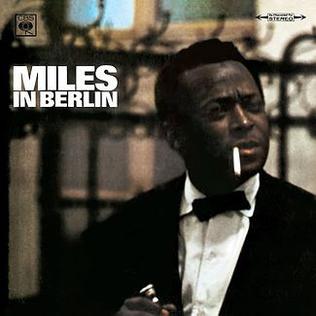
Miles in Berlin is a live album by Miles Davis from a performance at the Berliner Philharmonie on September 25, 1964 with his "Second Great Quintet," featuring tenor saxophonist Wayne Shorter, pianist Herbie Hancock, bassist Ron Carter and drummer Tony Williams, marking their first recorded work.

My Point of View is the second album by pianist Herbie Hancock. It was released in 1963 on Blue Note Records as BLP 4126 and BST 84126. Musicians featured are trumpeter Donald Byrd, trombonist Grachan Moncur III, tenor saxophonist Hank Mobley, guitarist Grant Green, bassist Chuck Israels and drummer Tony Williams.

Circle in the Round is a 1979 compilation album by jazz musician Miles Davis. It compiled outtakes from sessions across fifteen years of Davis's career that, with one exception, had been previously unreleased. All of its tracks have since been made available on album reissues and box sets.
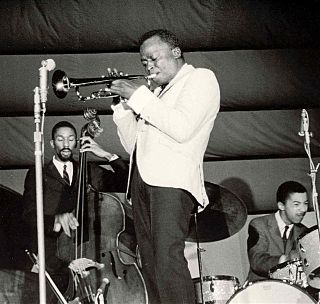
The Miles Davis Quintet was an American jazz band from 1955 to early 1969 led by Miles Davis. The quintet underwent frequent personnel changes toward its metamorphosis into a different ensemble in 1969. Most references pertain to two distinct and relatively stable bands: the First Great Quintet from 1955 to 1958, and the Second Great Quintet from late 1964 to early 1969, Davis being the only constant throughout.

Water Babies is a compilation album by American jazz trumpeter Miles Davis. It compiled music Davis recorded in studio sessions with his quintet in 1967 and 1968, including outtakes from his 1968 album Nefertiti and recordings that foreshadowed his direction on In a Silent Way (1969), while covering styles such as jazz fusion and post-bop. Water Babies was released by Columbia Records in 1976 after Davis had (temporarily) retired.

The Complete Studio Recordings of The Miles Davis Quintet 1965–1968 is a box set of six CDs covering the work of Miles Davis and his critically acclaimed second great quintet which featured Wayne Shorter, Herbie Hancock, Ron Carter and Tony Williams.
V.S.O.P. was an American jazz quintet consisting of Herbie Hancock, Wayne Shorter, Ron Carter (bass), Tony Williams (drums), and Freddie Hubbard . Hancock, Shorter, Carter, and Williams had all been members of Miles Davis' "Second Great Quintet" during the 1960s. The name V.S.O.P. is taken from a grade of Cognac brandy, where it signifies aged stock.

Directions is a compilation album by American jazz musician Miles Davis, released in 1981 by Columbia Records. It collects previously unreleased outtakes that Davis recorded between 1960 and 1970. Directions was the last of a series of compilation albums—mostly consisting of, at that time, previously unreleased music—that Columbia released to bridge Davis' recording hiatus that ended with the Man with the Horn in July 1981.

Live in Europe 1969: The Bootleg Series Vol. 2 is a 3 CD + 1 DVD live album of the Miles Davis Quintet featuring saxophonist Wayne Shorter, pianist Chick Corea, bassist Dave Holland, and drummer Jack DeJohnette. This particular line-up became known as "The Miles Davis Lost Quintet" as it did not record in the studio in this configuration. The CDs contain recordings of two concerts in France and one in Sweden and the DVD has an additional concert recorded in Germany.
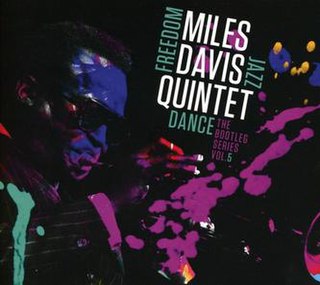
Freedom Jazz Dance: The Bootleg Series, Vol. 5 is a 3-CD box set by the Miles Davis Quintet compiling studio recordings by jazz trumpeter Miles Davis recorded between 1966 and 1968. The album contains remastered versions, alternate takes, and conversations among the musicians.



















